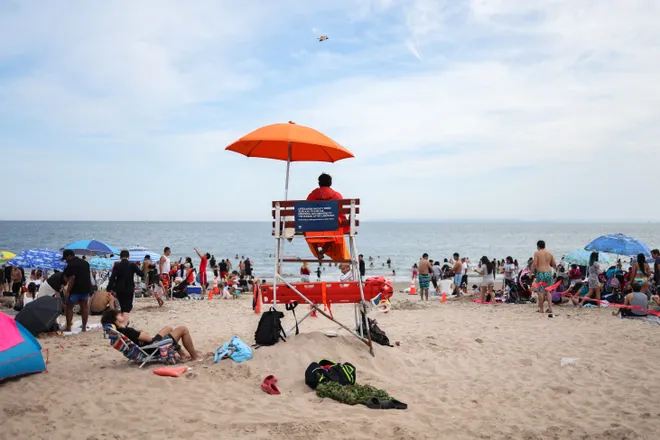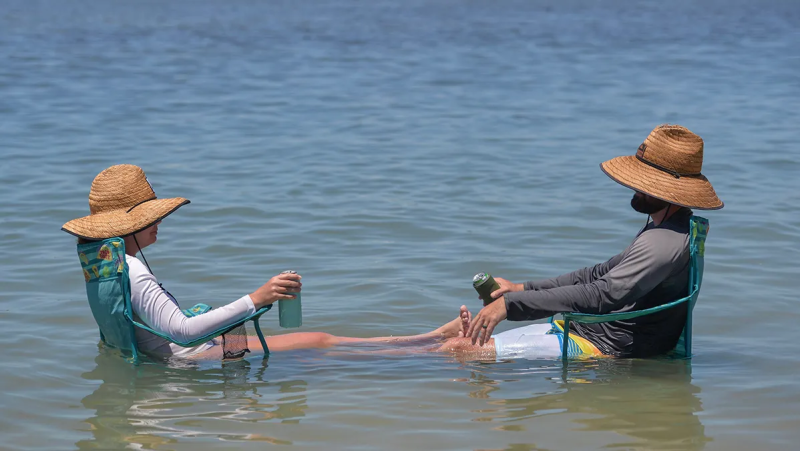Lifeguard shortage grips US as drownings surge, heat rages
A lifeguard shortage plaguing communities across the U.S. since the start of the pandemic has yet to relent.
As heat rages on across the U.S., access to desperately needed pools in some cities is curtailed or shut down. And from Wells, Maine, to Anchorage, Alaska, while beaches are open to the public, too few are being watched by lifeguards. People are advised to swim at their own risk.
About one-third of the nation’s public pools have beenaffected, causing reduced hours or closures, according to American Lifeguard Association estimates.
“Unfortunately, the impact this year is as severe as it has been in previous years,” Bernard Fisher, the ALA’s director of health and safety, told USA TODAY.
Drowning deaths have been on the rise, especially among young children. Local news reports are rife with concerns and deadly consequences. An outcry followed the deaths last week in New York City of two sisters who drowned at Coney Island Beach two hours after lifeguards ended their shifts.
Lifeguards are so critical in Florida that earlier this month, they made 21 water rescues in a single day off Panama City beaches, some of the deadliest in the U.S. due to rip currents. Six tourists died there last month, four within 48 hours – three taking a dip before evening shopping, the fourth a seminarian in training in town to shadow a student pastor.

What happened? What is causing the lifeguard shortage?
In the early days of the COVID-19 pandemic, pools and beaches were shuttered. Lifeguards moved on to other jobs or struggled to receive their proper certifications. Ever since then, experts say, the lifeguard industry has flailed.
In May 2019, about 144,000 people worked as lifeguards, ski patrol and other recreational safety jobs. That number dropped to just over 114,000 in 2021 and only reached 123,500 by May 2023, according to the Bureau of Labor Statistics.
At the same time, drownings skyrocketed from just over 4,000 in 2019 to more than 4,500 in 2022. The tragedy was compounded among Native Americans and Black people and for children between the ages of 1 and 4. In 2019, 392 toddlers died, and three years later, 461 drowned.
Like other cities across the country, Anchorage, Alaska, has been experiencing pronounced lifeguard shortages at its pools and beaches since the start of the pandemic, but the city’s Parks and Recreation Director Mike Braniff said the decline started even before then.
The city’s six indoor pools and two beaches would usually require between 40 and 50 lifeguards to staff at full capacity, Braniff said, but this summer, only about 15 are working.
“Our lifeguard numbers have declined to the point where we had to make a choice. Are we going to prioritize the lakes and sacrifice indoor programming, or vice versa?” he said.
The result: This summer, the city’s two public lake beaches are without lifeguard staff for the first time. Instead, signs reading “No lifeguard on duty, swim at your own risk” can be seen at the Jewel Lake and Goose Lake beaches.
Earlier in the season, a woman visiting Goose Lake on a busy day helped rescue two young girls who began having trouble out in the water when there were no lifeguards on duty, Braniff said.
“It certainly speaks to the need,” he said.

According to news reports, the shortage is impacting staffing at pools and other aquatic recreational areas in New York City, Milwaukee, Charlottesville and Burlington, Vermont. Beaches are also unstaffed or operating with reduced lifeguards in Westborough, Massachusetts and Bellingham, Washington.
In Connecticut, a shortage of open-water lifeguards has led to reduced services at half of the eight beaches this summer, meaning lifeguards are on duty only five days a week instead of all seven, the state's water safety coordinator with the State Parks Division, Sarah Battistini, said.
The recent drownings at unguarded beaches in New York have residents calling for more lifeguards and longer hours on duty, WABC-TV reported. In New York City, about 800 lifeguards are working with 100 more to start during the summer, but the city needs 1600 to fully staff its pools and beaches, the outlet reported.
Some good news: Community pools in some areas have rebounded
The shortage has abated in some parts of the country after several cities and states launched a massive push to recruit and retain more lifeguards last summer, including offering eye-popping bonuses and higher pay.
In Phoenix, lifeguards were eligible for thousands of dollars in bonuses if they finished the whole season last summer. Phoenix and other cities also increased base pay. Those efforts have done wonders for recruitment, Phoenix's Aquatics Supervisor Becky Kirk told USA TODAY.
"We’re clearly going in the right direction as far as training and recruiting more staff," Kirk said. She noted, though that the city was still only able to open 17 of its 29 pools at a time this summer – up from 15 last year – because it couldn't hire enough pool managers, who run point on water rescues and need years of prior lifeguard experience.
San Antonio's huge public outreach campaign to recruit new lifeguards has worked, the city's parks and recreation manager, Shanea Allen, told USA TODAY. This year, all 24 of its outdoor pools were able to be opened and the city hired its goal of 300 lifeguards for the second summer.
In 2022, the situation was "rough," Allen said, with delayed pool openings and adjusted hours. But the city boosted pay from $12.45 an hour to $17.50 in 2023 – and now $18 this year – and went all out to advertise the openings.
The department even decorated a parade float to promote its jobs.
“People really love seeing Parks out there in the community and staying active, and so we attribute a lot of our success to just being active in our community," Allen said. This year, about two-thirds of the staff are returning lifeguards.

All 11 of Tallahassee’s public pools also opened this summer, for the second year after facing serious staffing issues in previous years. Jackson, Mississippi, opened four public pools and three splash pads this year, up from only one of each last summer, when the city only had four lifeguards on staff.
In Tucson, Arizona, KGUN reported the city’s push to hire more lifeguards included pay raises and led to full staffing for this summer with all 20 pools open.
How to fix the lifeguard shortage?
In addition to financial incentives to attract lifeguards, ALA national spokesperson Wyatt Wernith said, an appreciation for the life-saving work they do and doing away with the stereotype that lifeguards are just menial summer jobs for teens is needed.
“It’s a lot of responsibility… what you've got to you gotta do when you’re a lifeguard, and you’re watching people’s lives and children, and (somebody could) die in front of you?” Wernith said.

Once-coveted lifeguard jobs are now seen as secondary to other summer options in retail or social media influencing, he said. And Braniff from Anchorage said he’s noticed fewer teenagers getting any kind of summer job year after year.
“When I became a lifeguard, you had ‘Baywatch,’ and everybody wanted to be lifeguards,” Wernith said.
The stringent requirements to become a lifeguard, depending on where you are, can include many hours of unpaid training and courses to get certified. In addition, starting pay isn’t much higher than a job with far fewer training and physical demands.
In Volusia County, Florida, lifeguards now make about $17 an hour and are eligible for bonuses, but must go through 48 hours of ocean rescue training, 44 hours of emergency medical responder classes and a CPR course and meet strict physical fitness requirements, the Daytona Beach News-Journal, part of the USA TODAY Network, reported.
FLORIDA LIFEGUARDS ON DUTY:Volusia County's award-winning lifeguards save lives by seeing things others don't
Implementing year-round recruitment efforts, pay increases, flexibility in scheduling and covering the cost of certification are a few ways to boost retention and new hires, experts say.
Wernith also hopes lifeguarding can be seen as a career path providing skills on par with EMTs and firefighters. Some employers could even tap people already in those professions to keep people safe in the water in times of high demand for lifeguards.
How to stay safe while you’re swimming with no lifeguard this summer
Experts say even in a lifeguard shortage, you should try to plan ahead and swim where there will be guards on duty. Wernith said you can also see if your area has positioned life rings you can use in case of emergency at beaches with no lifeguards.
But whether or not there’s a lifeguard present, the American Red Cross advises these water safety measures:
- Don’t ever swim alone, as an adult or a child. Never leave a young child unattended near water, and don’t trust another child to monitor children near water.
- Assign someone in your group the job of “water watcher” to keep a close eye on children and weak swimmers. You can rotate them in shifts so everyone gets a chance to relax and have fun.
- Use Coast Guard-approved life jackets for young children and inexperienced swimmers around water, but don’t only rely on the life jackets.
- Remember the saying, “Reach or throw, don’t go!” In an emergency, use an object to reach a person in trouble or throw it in the water so they can grab it. Don’t try to go in yourself, because you could also be in danger of drowning.
Disclaimer: The copyright of this article belongs to the original author. Reposting this article is solely for the purpose of information dissemination and does not constitute any investment advice. If there is any infringement, please contact us immediately. We will make corrections or deletions as necessary. Thank you.




